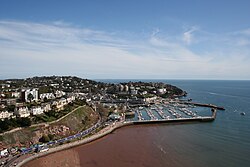English Riviera and South Devon
The English Riviera and South Devon is an area of Devon that lies between Exeter and Plymouth to the south of Dartmoor.
Cities
[edit]Towns
[edit]- 1 Brixham
- 2 Dartmouth
- 3 Dawlish
- 4 Kingsbridge and Salcombe
- 5 Newton Abbot
- 6 Paignton – part of the English Riviera, birthplace and residence of renowned author Agatha Christie
- 7 Teignmouth
- 8 Torquay – the nexus of the Riviera, immortalised in Fawlty Towers, this harbour-side town contrasts brilliantly white buildings with sparkling blue sea
- 9 Totnes – has a lively arts scene.
Other destinations
[edit]- 1 Dartmoor National Park is a swathe of moorland across the centre of the county.
Understand
[edit]The region has one of the mildest climates in England, in particular the Torbay area where the local geography has created a microclimate which, by English standards, is mild.
Until the mid-nineteenth century, the region was an agricultural area squeezed between Exeter, the de facto centre of government in the south-west and Plymouth, one of England's premier naval bases.

In the 1840s the Great Western Railway from London Paddington en route to Cornwall was built through the area. This connection, coupled with the mild climate, made the coastal region, in particular the Torbay area, popular with holiday makers, an attraction that has continues to the present day. Its proximity to Dartmoor has also made it an attractive base for those who wish to explore Dartmoor.
The good connections afforded by the railway system and latterly by the M5 motorway has attracted a number of niche industries to various market towns
Get in
[edit]By rail
[edit]See #Get around
By boat
[edit]Brittany Ferries carry vehicles and foot passengers to Plymouth from Roscoff, Saint-Malo (both France), or Santander (Spain).
Poole in Dorset is 80 mi (130 km) by road from Exeter, and receives Brittany Ferries from Cherbourg (France) and Condor Ferries from Saint Helier (Jersey). The other English Channel ferry ports are within a few hours' drive of Devon.
By plane
[edit]1 Exeter Airport (EXT IATA) has regular scheduled direct flights from Aberdeen, Alicante, Belfast, Dublin, Edinburgh, Glasgow, Guernsey, Jersey, Málaga, and Newcastle. A greater variety of international flights operates in summer, but these are mostly aimed at jetting locals to the Med.
Get around
[edit]By bus
[edit]The region has an extensive bus network which is aimed at local travel, so can be slow. Many services are subsidised by the local authorities and are therefore subject to the whims of local politicians who are trying serve their voters as well as balance the books. Up to date information can be found from the Devon County Council website.
By train
[edit]This region has two main railway lines - the Great Western Mainline that links Penzance to London Paddington and Birmingham via Taunton and Exeter. The line passes through Plymouth, Newton Abbott, typically carrying three or four trains an hour. The second line is the Riviera Line a local half-hourly service from Paignton to Exmouth via Torquay, Newton Abbott and Exeter. It uses the GWR main line between Newton Abbott and Exeter.
See
[edit]Do
[edit]Eat
[edit]Drink
[edit]Stay safe
[edit]Even though the crime rate in Devon is low, visitors should still take the normal precautions to remove temptations for petty pilfering. Visitors should also be aware that drunken behaviour increases during the holiday months.
Check the safety of beaches before entering the water. Many beaches have life guards on duty during the holiday season. It is also advisable to make local checks as to any pollution that might have been discharged into the sea.
Go next
[edit]The cities of Exeter and Plymouth are adjacent to the region, as is the Dartmoor National Park and if one is based in the region, these destinations can easily be visited.
Travelling westwards, one can visit Cornwall by crossing the Tamar River, one can go eastwards into East Devon or one can go northwards into Somerset and north-west into North Devon.


 Français
Français Italiano
Italiano




